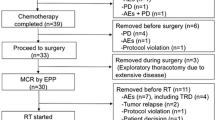Abstract
Objective
The aim of our study was to assess the efficacy of regional hyperthermia combined with intrapleural chemotherapy and to evaluate the effect on the immunologic cells and vascular endothelial growth factor (VEGF) in patients with malignant pleural effusion.
Methods
The 102 patients with malignant pleural effusion were included in this study: 52 patients undergoing regional hyperthermia with intrapleural chemotherapy (HICT), and 50 patients treated with intrapleural chemotherapy (ICT). Chemotherapy was administered into the thoracic cavity weekly through a tube with CDDP (dose = 40 mg/m2), and hyperthermia was performed twice a week for 60 minutes following the ICT. We evaluated the response rates and side-effects after 4 weeks. Before and after the treatment, T cell subsets and NK cells were detected by flow cytometry and VEGF was measured with ELISA kits.
Results
Compared HICT to ICT, the overall response rates of the whole group, breast cancers and lung cancers were 80.8% vs 54% (P < 0.01), 86.7% vs 56.3% (P > 0.05) and 78.4% vs 52.9% (P < 0.05) respectively. The ratios of CD4+, CD4+/CD8+ and NK cells increased and the concentration of VEGF decreased more significantly after HICT.
Conclusion
We concluded that combined regional hyperthermia with intrapleural chemotherapy could control the malignant pleural effusion effectively with mild toxicity. The levels of the T cell subset, NK cells and VEGF in both blood and effusion changed obviously.
Similar content being viewed by others
References
Conti M, De Giorgi U, Tazzari V, et al. Clinical pharmacology of intraperitoneal cisplatin-based chemotherapy. J Chemother, 2004, 16Suppl 5: 23–25.
Hildebrandt B, Wust P. Interactions between hyperthermia and cytotoxic drugs. Cancer Theat Res, 2007, 134: 185–193.
Dieing A, Ahlers O, Hildebrandt B, et al. The effect of induced hyperthermia on the immune system. Prog Brain Res, 2007, 162:137–152.
Sticca RP, Dach BW. Rationale for hyperthermia with intraoperative intraperitoneal chemotherapy agents. Surg Oncol Clin N Am, 2003, 12: 689–701.
Ohtsubo T, Saito H, Tanaka N, et al. Enhancement of cisplatin sensitivity and platinum uptake by 40 degrees C hyperthermia in resistant cells. Cancer Lett, 1997, 119: 47–52.
Gabano E, Colangelo D, Ghezzi AR, et al. The influence of temperature on antiproliferative effects, cellular uptake and DNA platination of the clinically employed Pt(II)-drugs. J Inorg Biochem, 2008, 102: 629–635.
Halamikova A, Vrana O, Kasparkova J, et al. Biochemical studies of the thermal effects on DNA modifications by the antitumor cisplatin and their repair. Chembiochem, 2007, 8: 2008–2015.
Matsuzaki Y, Shibata K, Yoshioka M, et al. Intrapleural perfusion hyperthermo-chemotherapy for malignant pleural dissemination and effusion. Ann Thorac Surg, 1995, 59: 127–131.
Hiraoka M, Jo S, Akuta K, et al. Radiofrequency capacitive hyperthermia for deep-seated tumors. I. Studies on thermometry. Cancer, 1987, 60: 121–127.
Xia H, Karasawa K, Hanyu N, et al. Hyperthermia combined with intra-thoracic chemotherapy and radiotherapy for malignant pleural mesothelioma. Int J Hyperthermia, 2006, 22: 613–621.
Jones E, Alvarez Secord A, Prosnitz LR, et al. Intra-peritoneal cisplatin and whole abdomen hyperthermia for relapsed ovarian carcinoma. Int J Hyperthermia, 2006, 22: 161–172.
Fatehi D, van der Zee J, Notenboom A, et al. Comparison of intratumor and intraluminal temperatures during locoregional deep hyperthermia of pelvic tumors. Strahlenther Onkol, 2007, 183: 479–486.
Panteix G, Beaujard A, Garbit F, et al. Population pharmacokinetics of cisplatin in patients with advanced ovarian cancer during intraperitoneal hyperthermia chemotherapy. Anticancer Res, 2002, 22: 1329–1336.
Ostberg JR, Ertel BR, Lanphere JA. An important role for granulocytes in the thermal regulation of colon tumor growth. Immunol Invest, 2005, 34: 259–272.
Kampinga HH. Cell biological effects of hyperthermia alone or combined with radiation or drugs: a short introduction to newcomers in the field. Int J Hyperthermia, 2006, 22: 191–196.
Mussa A, Sandrucci S, Zanon C. Intraoperative chemohyperthermia for advanced gastric cancer: a new procedure with closed abdomen and previously constructed anastomosis. Tumori, 2001, 87: S18–20.
Kanamori M, Ohmori K, Yasuda T, et al. Effects of hyperthermia and differentiation on cultured Dunn osteosarcoma cells. Cancer Detect Prev, 2003, 27: 76–81.
Rosberger DF, Coleman DJ, Silverman R, et al. Immunomodulation in choroidal melanoma: reversal of inverted CD4/CD8 ratios following treatment with ultrasonic hyperthermia. Biotechnol Ther, 1994, 5: 59–68.
Dieing A, Ahlers O, Kerner T, et al. Whole body hyperthermia induces apoptosis in subpopulations of blood lymphocytes. Immunobiology, 2003, 207: 265–273.
Kappel M, Poulsen TD, Galbo H, et al. Influence of minor increases in plasma catecholamines on natural killer cell activity. Horm Res, 1998, 49: 22–26.
Seo Y, Baba H, Fukuda T, et al. High expression of vascular endothelial growth factor is associated with liver metastasis and a poor prognosis for patients with ductal pancreatic adenocarcinoma. Cancer, 2000, 88: 2239–2245.
Sawaji Y, Sato T, Takeuchi A, et al. Anti-angiogenic action of hyperthermia by suppressing gene expression and production of tumourderived vascular endothelial growth factor in vivo and in vitro. Br J Cancer, 2002, 86: 1597–1603.
Author information
Authors and Affiliations
Corresponding author
Rights and permissions
About this article
Cite this article
Song, H., Chen, L., Wang, J. et al. Regional hyperthermia combined with intrapleural chemotherapy in patients with malignant pleural effusion. Chin. -Ger. J. Clin. Oncol. 10, 360–365 (2011). https://doi.org/10.1007/s10330-011-0791-x
Received:
Revised:
Accepted:
Published:
Issue Date:
DOI: https://doi.org/10.1007/s10330-011-0791-x




